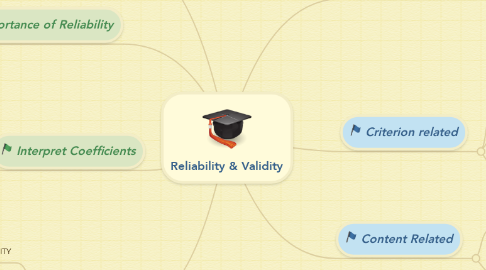
1. Interpret Coefficients
1.1. PRINCIPLE ONE
1.1.1. Higher coefficients from heterogenous versus homogeneous
1.2. PRINCIPLE TWO
1.2.1. Scoring limits score
1.3. PRINCIPLE THREE
1.3.1. Higher numbers equal higher reliabilty
2. Methods
2.1. TEST RETEST STABILITY
2.1.1. Testing multiple times to determine the correlation amongst scores
2.2. ALTERNATIVE FORM
2.2.1. Two forms need to be available. This takes a lot of effort
2.3. INTERNAL CONSISTENCY
2.3.1. Odd and even reliability split in half
3. Importance of Reliability
3.1. Reliability allows test to be taken multiple times to determine stability over time
4. Importance of Validity
4.1. Validity is accounted for when tests measure what they describe themselves to measure and nothing more
5. Coefficient Interpretation
5.1. PRINCIPLE 1
5.1.1. Concurrents higher than predicted
5.2. PRINCIPLE 2
5.2.1. Group variability affects size
5.3. PRINCIPLE 3
5.3.1. Relevance and Reliability should be considered
6. Content Related
6.1. INPECT QUESTIONS
6.1.1. Looking for problems with the questions themsleves
6.2. MEASURE OTHER ITEMS THAN WHAT DESIGNED FOR
6.2.1. Test requires multiple skills therefore presenting more variables than what is expected to measure
7. Criterion related
7.1. CONCURRENT
7.1.1. Measures at the same time it evaluates
7.2. PREDICTIVE
7.2.1. How well tests predicts future behaviors
7.3. CONSTRUCTIVE
7.3.1. How the test information relates to other information and theories
